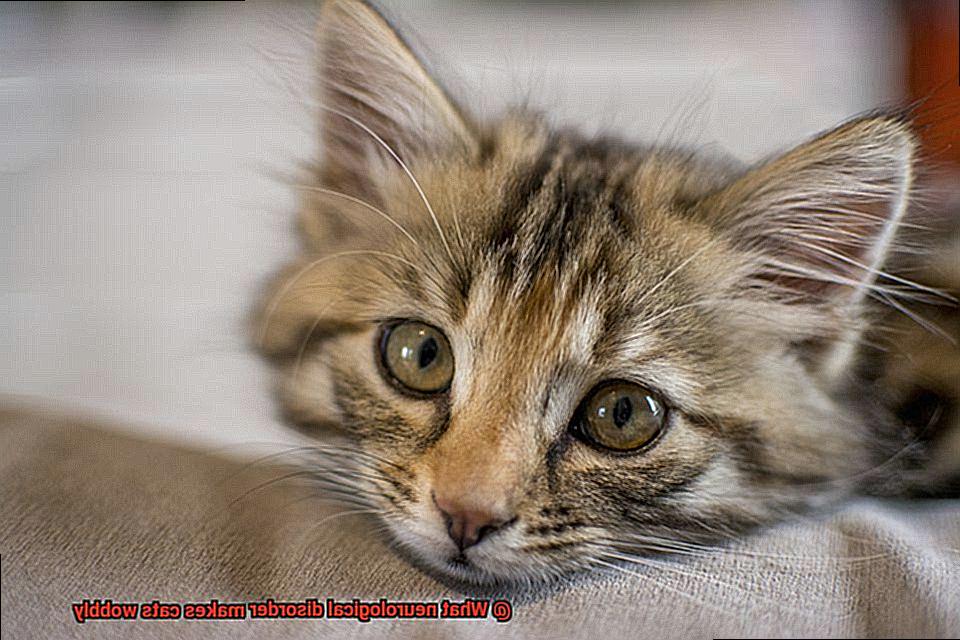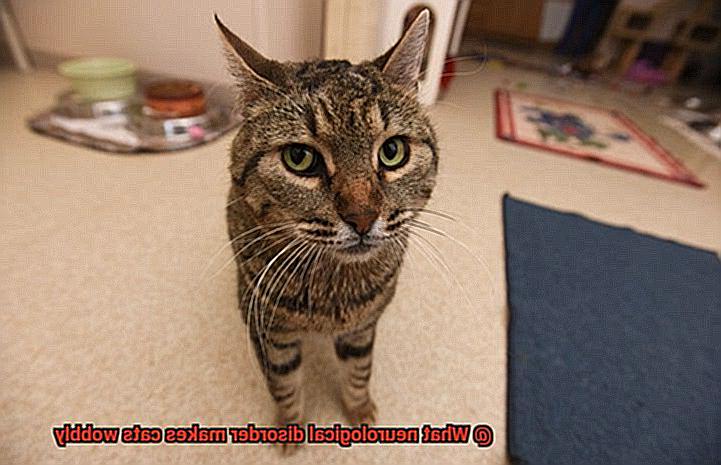Imagine this: you’re snuggled up with your furry feline friend, and suddenly they start stumbling around like a drunk sailor. It’s a worrisome sight, but luckily, it’s likely caused by a common neurological disorder in cats.
The culprit? Cerebellar hypoplasia. This condition affects a kitten’s ability to coordinate their muscles due to an underdeveloped cerebellum at birth. Symptoms include wobbliness, tremors, and difficulty walking straight. But don’t be fooled – there are other disorders that can also cause balance issues in cats.

Vestibular disease is another possibility, caused by inner ear problems that affect balance. Spinal cord injuries or nerve disorders can also lead to coordination struggles in our feline friends.
If you’ve noticed your cat struggling with their balance, don’t hesitate to seek veterinary help. Early diagnosis and treatment can make all the difference in helping your cat live their best life. Keep reading for more information on the neurological disorders that can impact our beloved pets.
What is Cerebellar Hypoplasia?
Your kitty may be suffering from cerebellar hypoplasia (CH), a neurological condition that affects balance and coordination. The cerebellum is responsible for these functions, and when it’s underdeveloped, cats with CH may have difficulty controlling their movements.
CH can be congenital or acquired. Congenital CH is caused by a viral infection that the mother cat contracted during pregnancy, while acquired CH can develop later in life due to trauma, infection, or other factors that damage the cerebellum. However, regardless of the cause, cats with CH can still live fulfilling lives with proper care.
Symptoms of CH include difficulty walking, jumping, and performing other movements that require balance and coordination. Cats with CH may also experience tremors or uncontrollable head movements. Despite these challenges, with proper care and management, they can learn to compensate for their lack of coordination and lead a normal life.
If you suspect that your cat has CH, consult with a veterinarian to determine the underlying cause of their wobbliness and develop an appropriate treatment plan. Treatment options may include physical therapy, medication, and supportive care.
To prevent injuries, it’s important to provide a safe environment for your cat. Cats with CH should be kept indoors to avoid any potential dangers such as falls or encounters with other animals. Regular veterinary check-ups are also crucial to monitor their health and ensure that any underlying conditions are addressed promptly.
Causes of Cerebellar Hypoplasia
If so, your furry friend could be suffering from cerebellar hypoplasia, a neurological disorder that affects their balance and coordination. But what causes this condition in cats?
One of the most common culprits behind cerebellar hypoplasia is infection with the feline panleukopenia virus (FPV) during pregnancy. Sadly, pregnant cats who are exposed to this virus can pass it on to their kittens, which can lead to cerebellar hypoplasia. However, it’s not just FPV that can cause this condition. Other viral infections like feline immunodeficiency virus (FIV) and feline leukemia virus (FeLV) can also contribute to cerebellar hypoplasia in cats.
But viruses aren’t the only things that can trigger cerebellar hypoplasia. Exposure to toxins or drugs during pregnancy, malnutrition, and genetic mutations may also contribute to this condition. Certain breeds of cats, such as Siamese and Himalayans, may also be more prone to developing cerebellar hypoplasia.
It’s important to note that not all cats with cerebellar hypoplasia are born with it. Some cats may develop this condition later in life due to head trauma or certain diseases that affect the brain.
If your beloved feline friend is struggling with cerebellar hypoplasia, rest assured that they can still lead a fulfilling life with proper care and management. A consultation with your veterinarian can lead to the development of an appropriate treatment plan including physical therapy, medication, and supportive care. Remember to provide a safe environment for your cat by keeping them indoors and scheduling regular check-ups to ensure their health is monitored closely.
Symptoms of Cerebellar Hypoplasia
They may be experiencing cerebellar hypoplasia (CH), a neurological disorder that affects their coordination and balance.
The cerebellum is an essential part of the brain responsible for controlling balance and coordination. When a cat has CH, it means that the cerebellum is not fully developed, causing them to experience symptoms such as an unsteady gait, difficulty walking in a straight line, and a tendency to fall over or stumble. Some cats may also experience shaking or tremors in their head or limbs.
It’s important to keep in mind that not all cats with CH will show the same symptoms. Some may only experience mild symptoms that don’t significantly impact their quality of life. However, severe cases of CH can make it difficult for a cat to perform basic activities like eating and grooming themselves.
Cats with CH are sometimes referred to as “wobbly cats” or “drunken cats,” but despite the challenges they face, most can still live happy and fulfilling lives with proper care and accommodations. With physical therapy, medication, and supportive care, owners can help their furry friends navigate the difficulties of this condition.

If you suspect your cat may have CH, consulting with a veterinarian is crucial to rule out other potential causes of their symptoms. With the right diagnosis and treatment plan, you can help your wobbly cat lead their best life possible.
Diagnosis and Treatment of Cerebellar Hypoplasia
The underdevelopment or incomplete formation of the cerebellum, responsible for movement coordination and balance, causes this neurological disorder in cats, making them appear wobbly or uncoordinated.
If you suspect your cat has cerebellar hypoplasia, a thorough physical examination by a veterinarian is imperative. Your vet will observe your cat’s gait and behavior and may perform additional tests to rule out other potential causes of their symptoms. Sadly, there is no cure for this condition as it is congenital, but several strategies can help manage it.

Environmental management is an effective strategy to reduce stress and improve your cat’s safety. Cats with cerebellar hypoplasia benefit from living in a quiet, low-stress environment with minimal obstacles or hazards that could lead to injury. Soft surfaces to walk on and elevated food and water bowls can also help improve their comfort and safety.
Physical therapy is another treatment option that can help improve coordination, balance, muscle tension, and stiffness. By designing exercises that target these areas specifically, you can help your cat move more comfortably and confidently.
In some cases, medications may be prescribed to manage specific symptoms associated with cerebellar hypoplasia. Anti-anxiety medications can help reduce stress levels in cats and improve their overall comfort level.
While cerebellar hypoplasia in cats cannot be cured, there are many treatment options available that can significantly improve your cat’s quality of life. With the right care and accommodations, your “wobbly cat” can still live a happy and fulfilling life.
Other Neurological Disorders that May Cause Wobbliness in Cats
However, sometimes you may notice them wobbling or having difficulty walking. While cerebellar hypoplasia is a well-known neurological disorder that can cause such symptoms in cats, there are other conditions that may be the root of the problem. In this article, we will explore some of the other neurological disorders that may cause wobbliness in cats.
One such disorder is cerebellar hypoplasia, which affects the cerebellum – the part of the brain responsible for coordinating movement and balance. Cats with cerebellar hypoplasia have a wobbly gait and may have difficulty standing or walking. This condition is usually congenital and can be caused by viral infections or malnutrition during pregnancy.
Another neurological disorder that can cause wobbliness in cats is vestibular disease. This condition affects the vestibular system, which is responsible for balance and spatial orientation. If your cat has vestibular disease, they may have a head tilt, loss of balance, and a wobbly gait. Vestibular disease can be caused by infections, trauma, tumors, or idiopathic reasons.
Feline spinal cord disorders can also lead to wobbliness in cats. These conditions affect the spinal cord, which is responsible for transmitting messages from the brain to the rest of the body. Spinal cord disorders can cause weakness, paralysis, and loss of coordination. Intervertebral disc disease, spinal cord trauma, and tumors are examples of spinal cord disorders that may cause wobbliness.
Finally, metabolic disorders such as hypoglycemia (low blood sugar) or hepatic encephalopathy (liver disease) can also cause wobbliness in cats. These conditions affect the metabolism of the body and can lead to neurological symptoms such as tremors, weakness, and loss of coordination.
It is crucial to seek veterinary care immediately if you notice any changes in your cat’s behavior or health, including wobbliness or other neurological symptoms. A thorough examination and diagnostic testing can help identify the underlying cause and guide appropriate treatment.
Living with a Cat with Cerebellar Hypoplasia
Living with a cat with Cerebellar Hypoplasia (CH) can be an enriching and fulfilling experience. This neurological disorder affects the cerebellum, the part of the brain responsible for coordination, balance, and fine motor skills. Cats with CH may appear wobbly or uncoordinated, but with proper care and accommodations, they can lead happy and healthy lives.
One of the most important things to consider when living with a cat with CH is safety. These cats may struggle with balance and coordination, so it’s essential to keep them indoors and provide soft surfaces for them to land on if they fall. With these precautions in place, you can prevent injuries and create a safe and secure environment for your feline companion.
Cats with CH may also need assistance with grooming and using the litter box. You can help by providing regular grooming sessions and using low-sided litter boxes to make it easier for them to access. By providing this extra support, you can ensure your cat is comfortable and content in their home.
It’s important to note that there is no cure for CH, but the disorder typically does not worsen over time. With love, support, and appropriate accommodations, cats with CH can thrive in their homes and bring joy to their owners. These cats have unique personalities and are known for their playful nature, making them wonderful companions for those willing to provide a little extra care.
Hj5BufbYhQg” >
Conclusion
To wrap up, it’s important to recognize that there are several neurological disorders that can cause cats to experience wobbliness or uncoordinated movement. One of the most common conditions is cerebellar hypoplasia (CH), which affects a kitten’s muscle coordination due to an underdeveloped cerebellum at birth. However, other disorders such as vestibular disease, spinal cord injuries, nerve disorders, and metabolic disorders like hypoglycemia or hepatic encephalopathy may also cause balance issues in cats.
If you notice your feline friend struggling with their balance, don’t hesitate to seek veterinary assistance right away. Early diagnosis and treatment can make a significant difference in helping your cat live their best life. For CH specifically, treatment options include physical therapy, medication, and supportive care. Additionally, environmental management is crucial to reduce stress and improve safety for cats with CH.
Living with a cat who has CH can be an incredibly rewarding experience if you provide them with proper care and accommodations. Safety should always be a top priority, and you may need to assist them with grooming or using the litter box. However, with love, support, and appropriate accommodations, cats with CH can thrive in their homes and bring joy to their owners.
In conclusion, having an understanding of the various neurological disorders that may cause wobbliness in cats is essential for early diagnosis and effective treatment.

